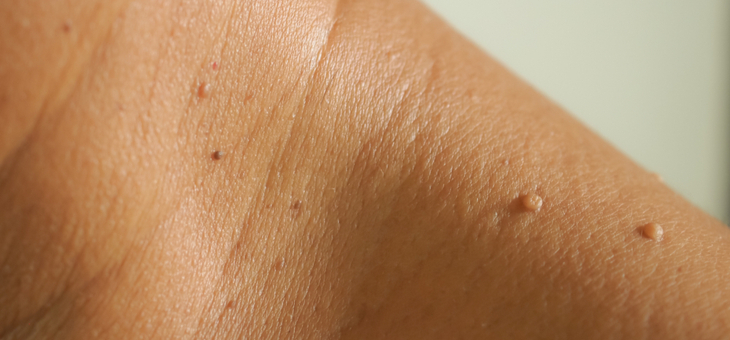Skin tags, also known as skin tabs or barnacles, are flaps of tissue, about the size of a grain of rice, that hang from the skin. They are most commonly found on the neck, crotch, eyelids and armpits, or in places that are frequently rubbed by tight-fitted clothing. Skin tags are more common in older people, although they can develop at any age. Nearly half of all people will develop a skin tag at some point in time.
They can grow on their own or in small clusters. They are usually the same colour as the surrounding skin. Skin tags are typically smaller than two millimetres, soft to touch, can be rounded or asymmetrical, and hang from the skin by a tiny ‘stalk’. On rare occasions, people have grown hundreds of them or have had an individual tag that has grown to the size of a grape, although this is unusual. Skin tags aren’t contagious, so they can’t spread from one person to another, or between areas of skin. They don’t cause irritation such as itchiness, pain or discomfort, so usually can be ignored.
Scientists still don’t know what causes skin tags to grow. Genetic factors, hormonal changes or clothing rubbing against skin may be to blame. Doctors have found that some factors may make people more likely to develop skin tags. Women who are pregnant and people with Crohn’s disease have a higher chance of developing skin tags. People who are overweight or obese, and individuals with diabetes and insulin resistance, are also more at risk. A 2008 study found human papillomavirus (HPV) in 50 per cent of the skin tags examined, suggesting that the virus may be linked to their growth.
While they are technically classified as a type of tumour, skin tags are harmless. They don’t increase the risk of you developing cancer, and they themselves are not cancerous.
As they don’t cause harm, doctors rarely recommend removing them. However, if a skin tag is bothering you, your doctor can use a number of methods to remove it.
Scissors or scalpel: The use of scissors is the most common method of removal, as it doesn’t discolour the skin and tags are usually so small that anaesthetic isn’t required.
Cryotherapy: Using liquid nitrogen to freeze the skin tag off.
Electrosurgery: Using high-frequency electrical energy to burn off the skin tag.
Ligation: Tying the skin tag off with a surgical thread, cutting off blood flow and causing it to fall off.
In some cases, skin tags may fall off on their own. Unlike some myths suggest, removing skin tags won’t cause more to grow in their place.
However, if you’ve noticed what looks like a skin tag that is fast growing, bleeds or is multicoloured, you should get it looked at by a medical professional. There are some more serious skin conditions that can resemble skin tags.
Do you have skin tags? Do they bother you? Would you ever consider having them removed?
If you enjoy our content, don’t keep it to yourself. Share our free eNews with your friends and encourage them to sign up.
Related articles:
https://www.yourlifechoices.com.au/health/wellbeing/skin-changes-you-should-know-about
https://www.yourlifechoices.com.au/health/covid19/prevent-dry-skin-from-handwashing
https://www.yourlifechoices.com.au/health/your-health/the-skin-check-mistake-i-made
Disclaimer: This article contains general information about health issues and is not advice. For health advice, consult your medical practitioner.

